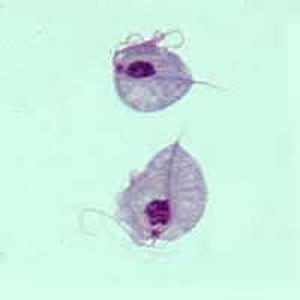It exists in a trophozoite form which shows wobbling motility. It is transmitted as an STD or by contaminated towels and underwear. It presents clinically as vaginitis with local burning, itching and frothy, foul smelling, yellowish vaginal discharge. It is usually accompanied by dysuria, increased urinary frequency and dyspareunia. Diagnosis is by direct microscopy showing motile trophozoites. Acridine orange or Papanicolaou staining can be done. Indirect haemagglutination can detect antibodies. ELISA is used for antigen detection. DNA probes and PCR are used for nucleic acid detection.

Two trophozoites of T. vaginalis obtained from in vitro culture, stained with Giemsa.